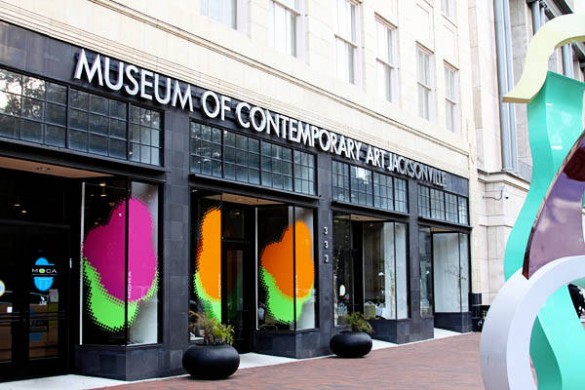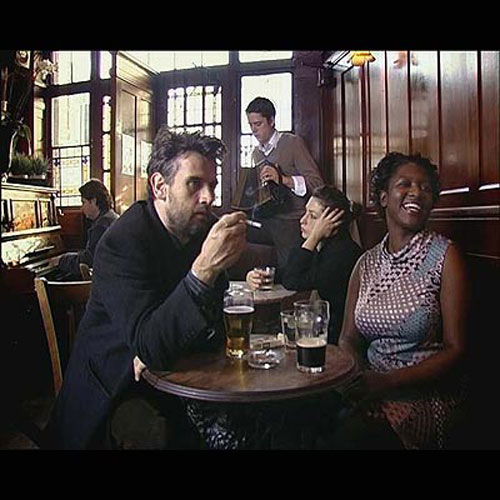There are no ticking clocks in this exhibit. No sand running through the hour glass to mark the passage of time. In fact there is almost nothing of literal time keeping in this terrific exhibition from Jacksonville’s Museum of Contemporary Art. Instead, this show is about the abstract nature of time. About what a subjective and personal experience it can be. The artists in this show are playing with time by speeding it up or slowing it down or sometimes stopping it completely. The exhibition staff at MoCA understands the power in this. Similar to the way looking at something too closely creates abstraction, so does viewing something too slowly.
Sam Taylor-Johnson, The Last Century,2005, DVD, Duration: 7 minutes 12 seconds, © Sam Taylor-Johnson, Courtesy White CubeIn SLOW, MoCA presents a dynamic exhibition more about immersion rather than passive viewership. Not only do visitors have to physically alter their pace in order to take in the work but a variety of worthwhile interpretive tools are also available to take the viewer deeper into the exhibition. These include a phone tour where one can access the voice of the artist offering a brief explanation of the corresponding work by dialing a number on their phone. Another tool offered that is a little more specific to the subject matter is what the museum describes as a “Left Brain/Right Brain” tour. This is presented as a printed component associated to each artist. On the left hand side of the sheet you have the “Left Brain” understanding of the work. The technical aspects, the process, the “how did they do it?” On the right hand side you’re presented with the “Right Brain” understanding. This falls closer to the “why” of art making. “What is the artist trying to tell me and why does it matter?” Taken together this information presents a compelling case. Particularly because of the technical nature of the work in the show and because most of said work involves the use of video which is still a young medium in the art world.

Idris Khan,Rising Series….. After Eadweard Muybridge ‘Human and Animal Locomotion’, 2005, 5 x Platinum prints, Each print 20 × 16 inches, Courtesy: Courtesy the Artist and Victoria Miro, London, Copyright: Idris Khan
A common thread throughout the exhibition is the preoccupation with the history of art. Both Idris Khan and James Nares reference the early years of photography in their work and both have at some point created images that are evocative of Eadweard Muybridge’s experiments with the medium. The difference being that while Khan’s are a more literal interpretation, Nares’ are more lyrical.
Sam Taylor-Johnson goes a step beyond the others by referencing the history of painting rather than the history of photography. In her video A Little Death 2002 we start with a scene that closely resembles Jan Weenix’s Still Life with Hare and other Hunting Booty 1697. The video looks very much like an old master still life in the beginning but through time-lapse photography we can see the accelerated decay and ruin of the once picturesque scene. The body of the hare falls apart as it is eaten away, taking the scene and pushing it to the logical conclusion the original couldn’t reach.

David Claerbout, Ruurlo, Boculorscheweg, 1910, 1997, single channel video projection, black & white, silent, 10 min loop, Courtesy to the artist and Yvon Lambert, Hauser & Wirth, Micheline Szwajcer
Other highlights include David Claerbout’s The Long Goodbye depicting a woman emerging onto the steps of a grand country house, recognizing the viewer and waving to us as our point of view pulls away and the scene fades to black. This unbroken shot probably would not span even a minute in real time but in Claerbout’s vision it stretches to nearly ten. At such a snail’s pace every tiny gesture can be examined and becomes significant.
This idea is taken further in James Nares’ brilliant video Street 2011. In what I felt was the most moving piece in the exhibition, we as the viewer are gliding along crowded New York streets watching the people around us move by in slow-motion. The small, mundane gestures are now multiplied by the hundreds. The video has a strange, voyeuristic quality to it. At this slowed pace we are at leisure to examine the faces and expressions of the people in crowd. None of which, amazingly, ever look back at the camera. In this way, and with the addition of a stirring soundtrack, the everyday activities of these New Yorkers are elevated to cinematic levels. And at just over an hour in length it’s not hard to imagine the work as coming close to the realm of mainstream cinema.
All in all MoCA has done a great job creating an exhibition that is not only cohesive but exciting – not an easy task. Take the time to visit this show, and once there, take the time to slow down and watch it unfold. SLOW: Marking Time in Photography and Film is currently installed at MoCA Jacksonville and runs through April 7th.





